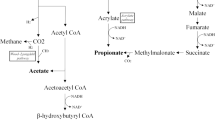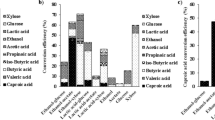Abstract
Biogenic amines are a group of microbial metabolites detected in fermented foods that have potential health risk. Reduction of biogenic amines in fermented foods by enzymes is an effective and safe approach as it has less influences on food flavor and fermentation process. In this work, a multicopper oxidase named as MCOP from Lactobacillus paracasei XJ02 was successfully expressed in E. coli BL21 (DE3). The Km and Vmax of MCOP were detected to be 4.34 mmol/L and 5.61 mmol/ (L· min), respectively. MCOP was resistant to acidic condition and was stable at a wide temperature range (4oC−65oC). Activity of MCOP was significantly inhibited by 5−20% NaCl, whereas it was dramatically increased in the presence of 5−20% ethanol. This enzyme significantly degraded putrescine and cadaverine in soy sauce with a degradation rate of 10.3% of total BAs. Moreover, addition of MCOP efficiently reduced the content of histamine and putrescine in huangjiu by 41.1% and 19.8%, respectively. The degradation rate for total biogenic amines in huangjiu was 20.5%. The results demonstrated the good performance of an ethanol tolerant multicopper oxidase in reduction of biogenic amines in alcohol beverages. This provides potential enzyme candidates for being used in food safety control.





Similar content being viewed by others
References
Durak-Dados A, Michalski M, Osek J. Histamine and other biogenic amines in food. J Vet Res. 2020;64(2):281–88. https://doi.org/10.2478/jvetres-2020-0029.
Ruiz-Capillas C, Herrero AM. Impact of biogenic amines on food quality and safety. Foods. 2019;8(2):62. https://doi.org/10.3390/foods8020062.
**a XL, Zhang QW, Zhang B, Zhang WJ, Wang W. Insights into the biogenic amine metabolic landscape during industrial semidry Chinese rice wine fermentation. J Agric Food Chem. 2016;64(39):7385–93. https://doi.org/10.1021/acs.jafc.6b01523.
Gao XL, Li C, He R, Zhang Y, Wang B, Zhang Z, Ho C. Research advances on biogenic amines in traditional fermented foods: emphasis on formation mechanism, detection and control methods. Food Chem. 2023;405:134911. https://doi.org/10.1016/j.foodchem.2022.134911.
Li BB, Xu Y, Niu SH, Zhang N, Li W, Song GS, Zhang RY, Yang Y. Research progress on biogenic amine content and biogenic amine oxidase in food. Food Sci. 2019;40(01):341–47. https://doi.org/10.7506/spkx1002-6630-20171205-054.
Klementová L, Purevdorj K, Butor I, Jancová P, Bábková D, Bunka F, Bunková L. Reduction of histamine, putrescine and cadaverine by the bacteria Lacticaseibacillus casei depending on selected factors in the real condition of the dairy product. Food Microbiol. 2024;117:104391. https://doi.org/10.1016/j.fm.2023.104391.
Lee JI, Kim YW. Characterization of amine oxidases from Arthrobacter aurescens and application for determination of biogenic amines. World J Microbiol Biotechnol. 2013;29(4):673–82. https://doi.org/10.1007/s11274-012-1223-y.
Ni XM, Yang T, Fang F. Biogenic amines-degrading enzymes and their applications: a review. Microbiol China. 2021;48(11):4398–411. https://doi.org/10.13344/j.microbiol.china.210201.
Pintus F, Sabatucci A, Maccarrone M, Dainese E, Medda R. Amine oxidase from Euphorbia characias: kinetic and structural characterization. Biotechnol Appl Biochem. 2018;65(1):81–8. https://doi.org/10.1002/bab.1612.
Chauhan PS, Goradia B, Saxena A. Bacterial laccase: recent update on production, properties and industrial applications. 3 Biotech. 2017;7:323. https://doi.org/10.1007/s13205-017-0955-7.
Callejon S, Sendra R, Ferrer S, Pardo I. Cloning and characterization of a new laccase from Lactobacillus plantarum J16 CECT 8944 catalyzing biogenic amines degradation. Appl Microbiol Biotechnol. 2016;100(7):3113–24. https://doi.org/10.1007/s00253-015-7158-0.
Callejon S, Sendra R, Ferrer S, Pardo I. Recombinant laccase from Pediococcus acidilactici CECT 5930 with ability to degrade tyramine. PLoS One. 2017;12(10):e0186019. https://doi.org/10.1371/journal.pone.0186019.
Xu J. Characterization and heterologus expression of multicopper oxidases for degradation of biogenic amines. Wuxi: Jiangnan University; 2019.
Olmeda I, Casino P, Collins RE, Sendra R, Callejon S, Huesa J, Soares AS, Ferrer S, Pardo I. Structural analysis and biochemical properties of laccase enzymes from two Pediococcus species. Microb Biotechnol. 2021;14(3):1026–43. https://doi.org/10.1111/1751-7915.13751.
Li T, Huang L, Li Y, Xu Z, Ge X, Zhang Y, Wang N, Wang S, Yang W, Lu F, Liu Y. The heterologous expression, characterization, and application of a novel laccase from Bacillus velezensis. Sci Total Environ. 2020;713:136713. https://doi.org/10.1016/j.scitotenv.2020.136713.
Yang QH, Zhang ML, Zhang MM, Wang CQ, Liu YY, Fan XJ, Li H. Characterization of a novel, cold-adapted, and thermostable laccase-like enzyme with high tolerance for organic solvents and salt and potent dye decolorization ability, derived from a marine metagenomic library. Front Microbiol. 2018;9:2998. https://doi.org/10.3389/fmicb.2018.02998.
Wang XF, Zhao YS, Zhang SF, Lin XP, Liang HP, Chen YX, Ji CF. Heterologous expression of the Lactobacillus sakei multiple copper oxidase to degrade histamine and tyramine at different environmental conditions. Foods. 2022;11(20):3306. https://doi.org/10.3390/foods11203306.
Guo X, Zhou S, Wang YW, Song JL, Wang HM, Kong DL, Zhu J, Dong WW, He MX, Hu GQ, Ruan ZY. Characterization of a highly thermostable and organic solvent-tolerant copper-containing polyphenol oxidase with dye-decolorizing ability from Kurthia Huakuii LAM0618T. PLoS One. 2016;11(10):e0164810. https://doi.org/10.1371/journal.pone.0164810.
Callejón S, Sendra R, Ferrer S, Pardo I. Identification of a novel enzymatic activity from lactic acid bacteria able to degrade biogenic amines in wine. Appl Microbiol Biotechnol. 2014;98(1):185–98. https://doi.org/10.1007/s00253-013-4829-6.
Yang S, Long Y, Yan H, Cai HW, Li YD, Wang XG. Gene cloning, identification, and characterization of the multicopper oxidase CumA from Pseudomonas sp. 593. Biotechnol Appl Biochem. 2017;64(3):347–55. https://doi.org/10.1002/bab.1501.
Bian YQ, Xu GC, Ni Y. Optimization of fermentation conditions for production of diacetyl reductase using recombinant Escherichia coli. J Food Sci Biotechnol. 2017;36(09):944–50. https://doi.org/10.3969/j.issn.1673-1689.2017.09.009.
Agbo P, Heath JR, Gray HB. Modeling dioxygen reduction at multicopper oxidase cathodes. J Am Chem Soc. 2014;136(39):13882–87. https://doi.org/10.1021/ja5077519.
Li L, Zou D, Ruan LY, Wen ZY, Chen SW, Xu L, Wei X. Evaluation of the biogenic amines and microbial contribution in traditional Chinese sausages. Front Microbiol. 2019;10:872. https://doi.org/10.3389/fmicb.2019.00872.
Luo QQ, Shi RY, Gong PF, Liu YT, Chen W, Wang CT. Biogenic amines in huangjiu (Chinese rice wine): formation, hazard, detection, and reduction. LWT-Food Sci Technol. 2022;168:113952. https://doi.org/10.1016/j.lwt.2022.113952.
Yang J, Li WJ, Ng TB, Deng XZ, Lin J, Ye XY. Laccases: production, expression regulation, and applications in pharmaceutical biodegradation. Front Microbiol. 2017;8:832. https://doi.org/10.3389/fmicb.2017.00832.
Reiss R, Ihssen J, Thöny-Meyer L. Bacillus pumilus laccase: a heat stable enzyme with a wide substrate spectrum. BMC Biotechnol. 2011;11:9. https://doi.org/10.1186/1472-6750-11-9.
Koschorreck K, Richter SM, Ene AB, Roduner E, Schmid RD, Urlacher VB. Cloning and characterization of a new laccase from Bacillus licheniformis catalyzing dimerization of phenolic acids. Appl Microbiol Biotechnol. 2008;79(2):217–24. https://doi.org/10.1007/s00253-008-1417-2.
Huy ND, Le NTM, Chew KW, Park SM, Show PL. Characterization of a recombinant laccase from Fusarium oxysporum HUIB02 for biochemical application on dyes removal. Biochem Eng J. 2021;168:107958. https://doi.org/10.1016/j.bej.2021.107958.
Martins LO, Soares CM, Pereira MM, Teixeira M, Costa T, Jones GH, Henriques AO. Molecular and biochemical characterization of a highly stable bacterial laccase that occurs as a structural component of the Bacillus subtilis endospore coat. J Biol Chem. 2002;277(21):18849–59. https://doi.org/10.1074/jbc.M200827200.
Sondhi S, Sharma P, Saini S, Puri N, Gupta N. Purification and characterization of an extracellular, thermo-alkali-stable, metal tolerant laccase from Bacillus tequilensis SN4. PLoS One. 2014;9(5):e96951. https://doi.org/10.1371/journal.pone.0096951.
Brander S, Mikkelsen JD, Kepp KP. Characterization of an alkali- and halide-resistant laccase expressed in E. coli: CotA from Bacillus clausii. PLoS One. 2014;9(6):e99402. https://doi.org/10.1371/journal.pone.0099402.
Jimenez-Juarez N, Roman-Miranda R, Baeza A, Sánchez-Amat A, Vazquez-Duhalt R, Valderrama B. Alkali and halide-resistant catalysis by the multipotent oxidase from Marinomonas mediterranea. J Biotechnol. 2005;117(1):73–82. https://doi.org/10.1016/j.jbiotec.2005.01.002.
Ruijssenaars HJ, Hartmans S. A cloned Bacillus halodurans multicopper oxidase exhibiting alkaline laccase activity. Appl Microbiol Biotechnol. 2004;65(2):177–82. https://doi.org/10.1007/s00253-004-1571-0.
Fang F, Yang T, Zhou JW, Chen J, Du GC, Xu J. Multicopper oxidase mutant with improved salt tolerance. US. 2021;11008552:B2.
García-Ruiz A, González-Rompinelli EM, Bartolomé B, Moreno-Arribas MV. Potential of wine-associated lactic acid bacteria to degrade biogenic amines. Int J Food Microbiol. 2011;148(2):115–20. https://doi.org/10.1016/j.ijfoodmicro.2011.05.009.
Liu SP, Yu JX, Wei XL, Ji ZW, Zhou ZL, Meng XY, Mao J. Sequencing-based screening of functional microorganism to decrease the formation of biogenic amines in Chinese rice wine. Food Control. 2016;64:98–104. https://doi.org/10.1016/j.foodcont.2015.12.013.
Cheng SM, Xu Y, Lan X. Isolation, characterization, and application of biogenic amines-degrading strains from fermented food. J Food Saf. 2020;40(1):e12716. https://doi.org/10.1111/jfs.12716.
Funding
This work was supported by the National Natural Science Foundation of China (32172182).
Author information
Authors and Affiliations
Corresponding author
Ethics declarations
Conflict of interest
The authors declare that there are no conflicts of interest.
Additional information
Publisher’s Note
Springer Nature remains neutral with regard to jurisdictional claims in published maps and institutional affiliations.
Rights and permissions
Springer Nature or its licensor (e.g. a society or other partner) holds exclusive rights to this article under a publishing agreement with the author(s) or other rightsholder(s); author self-archiving of the accepted manuscript version of this article is solely governed by the terms of such publishing agreement and applicable law.
About this article
Cite this article
Wei, L., **a, X. & Fang, F. Identification of an alcohol tolerant multicopper oxidase for reduction of biogenic amines in fermented foods. Syst Microbiol and Biomanuf 4, 699–707 (2024). https://doi.org/10.1007/s43393-024-00246-y
Received:
Revised:
Accepted:
Published:
Issue Date:
DOI: https://doi.org/10.1007/s43393-024-00246-y




